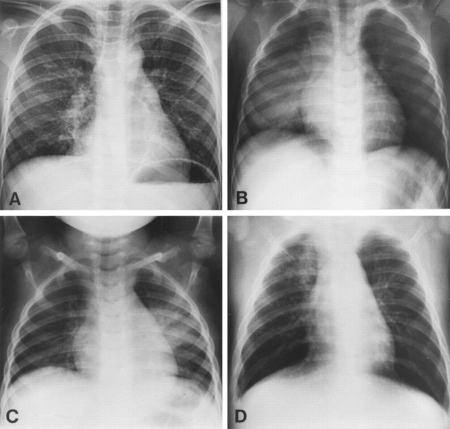Summary
Definition
History and exam
Key diagnostic factors
- fever
- cough
- hypoxemia
- tachypnea
- increased work of breathing
- abnormal auscultatory findings
- cyanosis
- apnea
Other diagnostic factors
- dyspnea
- tachycardia
- wheeze
- prolonged capillary refill time (CRT)
- chest pain
- abdominal pain
- vomiting
- difficulty feeding
- agitation or altered mental status
- night sweats
Risk factors
- younger age (<2 years old)
- male sex
- prematurity
- chronic underlying condition
- history of severe and/or complicated and/or recurrent pneumonia
- inhaled foreign body
- indoor air pollution
- overcrowded housing
- parental smoking
- anatomic lesion such as vascular ring or sling
Diagnostic tests
Tests to consider
- chest x-ray
- CBC
- serum electrolytes/BUN
- acute phase reactants
- blood cultures
- polymerase chain reaction (PCR) assays
- sputum culture
- pleural fluid culture
- endotracheal aspirate culture/PCR testing
- bronchoscopy
- chest ultrasound
- chest CT
Treatment algorithm
Contributors
Authors
Giovanni Piedimonte, MD, FAAP, FCCP
Vice-President for Research and Professor of Pediatrics, Biochemistry and Molecular Biology
Department of Pediatrics, Biochemistry and Molecular Biology
Tulane University
New Orleans
LA
Disclosures
GP declares that he has no competing interests.
Sara Manti, MD, PhD
University Researcher
Pediatric Unit
Department of Human Pathology of Adult and Evolutive Age "Gaetano Barresi"
University of Messina
Messina
Sicily
Italy
Disclosures
SM declares that she has no competing interests.
Peer reviewers
Brian Alverson, MD
Professor of Pediatrics
Sidney Kimmel Medical College
Thomas Jefferson University
Philadelphia
PA
Disclosures
BA declares that he has no competing interests.
Alasdair Munro, BSc (Hons), BM, PhD
Senior Clinical Research Fellow In Paediatric Infectious Diseases
NIHR Southampton Clinical Research Facility
Southampton General Hospital
Southampton
UK
Disclosures
AM declares that he has no competing interests.
Saul N. Faust, MBBS, FRCPCH, PhD, FHEA, OBE
Professor of Paediatric Immunology And Infectious Diseases
University of Southampton
Southampton
UK
Disclosures
SNF acts on behalf of University Hospital Southampton NHS Foundation Trust as an investigator and/or providing consultative advice on clinical trials and studies of vaccines and antimicrobials funded or sponsored by manufacturers including Sanofi, Moderna, Janssen, Pfizer, AstraZeneca, GlaxoSmithKline, Novavax, Seqirus, MedImmune, Merck, and Valneva. He receives no personal financial payment for this work.
Peer reviewer acknowledgements
BMJ Best Practice topics are updated on a rolling basis in line with developments in evidence and guidance. The peer reviewers listed here have reviewed the content at least once during the history of the topic.
Disclosures
Peer reviewer affiliations and disclosures pertain to the time of the review.
References
Key articles
Bradley JS, Byington CL, Shah SS, et al. The management of community-acquired pneumonia in infants and children older than 3 months of age: clinical practice guidelines by the Pediatric Infectious Diseases Society and the Infectious Diseases Society of America. Clin Infect Dis. 2011 Oct;53(7):e25-76.Full text Abstract
Harris M, Clark J, Coote N, et al; British Thoracic Society Standards of Care Committee. British Thoracic Society guidelines for the management of community acquired pneumonia in children: update 2011. Thorax. 2011 Oct;66 Suppl 2:ii1-23.Full text Abstract
Centers for Disease Control and Prevention. Child and adolescent immunization schedule by age: recommendations for ages 18 years or younger, United States, 2024. Nov 2023 [internet publication].Full text
Chan SS, Kotecha MK, Rigsby CK, et al; Expert Panel on Pediatric Imaging. ACR appropriateness criteria®: pneumonia in the immunocompetent child. J Am Coll Radiol. 2020 May;17(5 Suppl):S215-25.Full text Abstract
Reference articles
A full list of sources referenced in this topic is available here.

Guidelines
- ACR appropriateness criteria: pneumonia in the immunocompetent child
- The management of community-acquired pneumonia in infants and children older than 3 months of age: clinical practice guidelines by the Pediatric Infectious Diseases Society and the Infectious Diseases Society of America (archived)
Videos
Late inspiratory crackles (rales)
More videos
Use of this content is subject to our disclaimer
